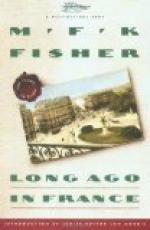Grandmother never resorted to very drastic measures. The most violent thing she ever did was to get little Annie, Bridget-the-housewoman’s Annie, to help her chase them out. They went from room to room periodically (when flies became too numerous), each armed with an old sawed-off broom-handle on which were tacked long cloth streamers — a sort of cat-o’-nine-tails effect, only with about a score or more of tails. After herding the blue-bottles and all their kith and kin into a fairly compact bunch at the door, little Annie opened the screen and grandmother drove them out — and that’s all there was to it.
Another favorite device (particularly in the dining-room and kitchen), was the “fly-gallery” — a wonderful array of multicolored tissue-paper festooned artistically from the ceiling or around the gas-pipes to lure or induce the fly into moments of inactivity. There was no extermination in this device — it was purely preventive in its function — the idea being that since there must be fly-specks, better to mass them as much as possible on places where they would show the least and could be removed the easiest when sufficiently accumulated.
But the greatest ounce-of-prevention was the screen hemisphere. Gee! I haven’t thought of that thing for years, have you? Of course you remember it — absolutely fly-proof — one clapped over the butter, another over the crackerbowl, another over the sugar!
And say! I almost forgot! . . . (Yes, I know you were just going to speak of it!) . . . That conical screen fly-trap where the flies see something good inside, crawl up to the top and then over and in — and then can’t get out — but just buzz and buzz and buzz — and make a lot of fuss about it — bluebottles and all — no respecter of persons — and when it gets full of the quick and dead in flydom, Bridget takes it out in the back yard and dumps it. Very simple . . . clean, peaceful, effective.
My, My! But it’s a far cry back to those days, isn’t it? And wouldn’t you like right this minute to sneak into the cool, curtain-down, ever-so-quiet dining-room again . . . and nose around to see if anything edible bad been overlooked — and see one of those dear old round fly-screens guarding the sugar!
The Autumn Leaves
There were three recognized uses for leaves in the Autumn — first, to be banked by the wind along fences or sidewalk edges and provide kicking-ground for exuberant youngsters returning home from school; second, to be packed around the foundations of the house as a measure for interior comfort in winter; and, third, to be pressed between the pages of the big Bible and kept for ornamental purposes until they crumbled and had to be thrown away. This last-named use was always questioned by every red-blooded boy, and more tolerated than accepted — a concession to the women of earth, from little sister with her bright-hued wreath to mother and grandmother with their book of pressed leaves.




